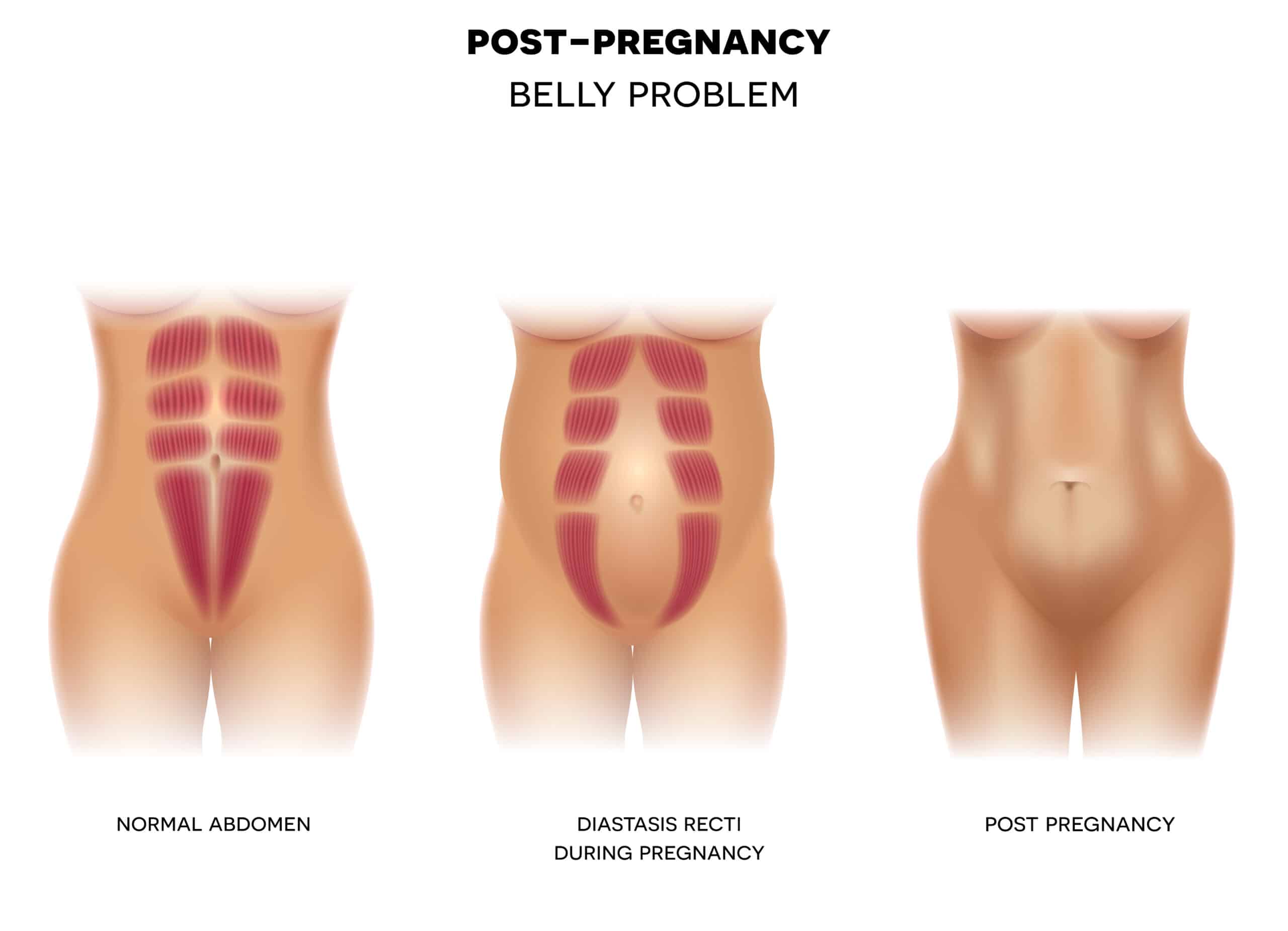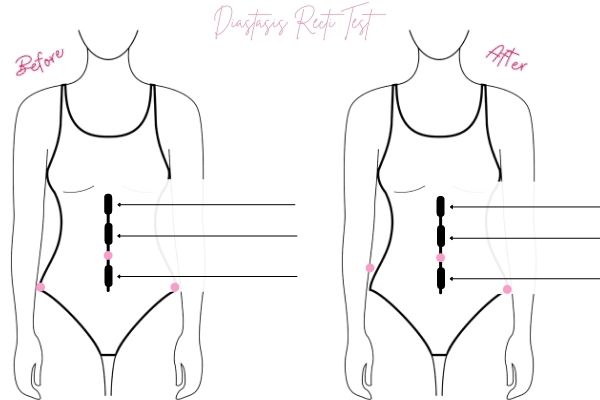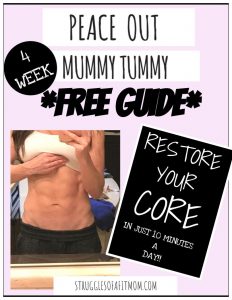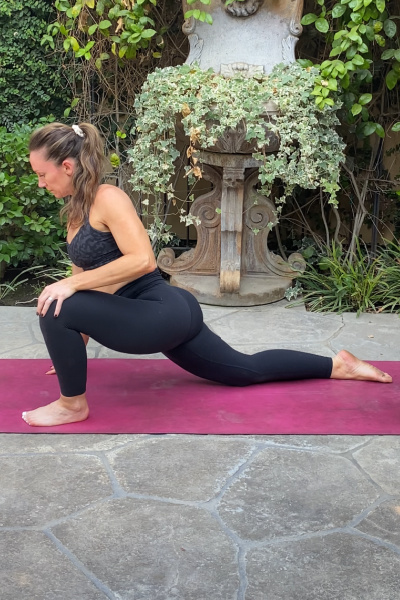6 Exercises to Heal The Lingering Postpartum Belly Pooch
If you are wondering why no matter what you do, you cannot seem to get rid of the postpartum belly pooch, or “mummy tummy”, you could have lingering abdominal separation known as “Diastasis Recti”.
Not to fear, this is a completely normal side effect of pregnancy and whether you are five months postpartum or five years, it’s never too late to start healing your core.

While society might pressure you to “love your postpartum body”, you do not have to accept the physical changes to your body after baby as your new normal.
Because one thing this “body love” movement fails to awknowledge is that pregnancy and childbirth can cause injury to our bodies which need to be healed through proper exercise and strength training in order to function properly.
Because let’s be honest, no one confidently pees their pants when they laugh, sneeze or jump.
Postpartum body confidence is challenging when there is a lack of optimal body function caused from a weakened core after pregnancy.
In this post, I share everything you should know about Diastasis Recti and exercises that have helped me restore my core after all three of my pregnancies.
Do you know what is more beautiful and admirable than a flat tummy and toned abs?
A woman who willingly sacrifices her body, time, independence and sometimes sanity for the development, birth and life that she gives to her children!
struggles of a fit mom
(This post probably contains affiliate links. I receive a small commission at no cost to you through links shared on this website to help keep the information I provide free to you)
What is Diastasis Recti?
You may know Diastasis Recti as the “mummy tummy” or the lingering “post-baby pooch”.
Diastasis Recti is simply abdominal separation during pregnancy.
However, this has quickly become a HUGE fear of many moms but as scary as it may sound, this separation is completely normal, natural and healthy.
The problem comes when we are not away of this naturally occurring process and do things that can potentially make it worse.
The depth and width of the separation that remains after pregnancy can cause many problems such as urinary incontinence, chronic back, pelvic pain, and a belly pooch that seems impossible to get rid of.
How Pregnancy Affects Your Core
Your abdominal muscles are actually composed of two hemispheres of muscles that are connected by a thin connective tissue called the “Linea Alba.”
During pregnancy, this connective tissue stretches in order to make room for the growing fetus.

This separation is the body’s natural way of making room for your baby!
With that said, as this connective tissue stretches, we lose some strength in our core muscles and need to be aware of movements that can place extra stress on this thin tissue.
Incorrect movements, incorrect exercising and incorrect breathing can put too much pressure on this tissue, potentially causing a larger than necessary separation which may be more challenging to heal postpartum.
If your Diastasis has not closed at 8-12 weeks post birth then specific strengthening exercises are necessary to help the gap close and improve core strength and function.
Why Does it Matter If I Have Diastasis Recti?
A strong core is much more than just losing the pooch and getting your abs back after pregnancy.
It is about developing proper strength, support and and most importantly, function of your entire body.
In both my personal and professional experience, too many women underestimate the importance of having a strong core and pelvic floor after pregnancy.
They are left suffering in silence from things like chronic back pain, urinary incontinence, painful intercourse, pelvic organ prolapse or an overall feeling of disconnect from your body.
And if you are trying to exercise to lose unwanted baby weight, the chances of you sticking to a workout program is very slim if you keep peeing your pants.
Healing your core and pelvic floor will help you feel stronger, more confident in your postpartum body.
Related: 8 Realistic Tips To Lose Weight While Breastfeeding
How Do I Know If I Have Diastasis Recti?
Diastasis Recti is often characterized as a protruding postpartum stomach that does not reduce despite regular exercise and healthy eating.
One of the the most obvious sign that you have any abdominal separation is if you notice any “coning” or protruding down the midline of your belly.
This indicates that the connective tissue between the rectus abdominis (your six pack) muscles is weak and cannot maintain proper support of the core and the organs which results in a noticeable protrusion or “pooch”.
In some cases, the abdominal muscles will close on their own after pregnancy.
However, for most, these muscles can remain separated for months, even years unless proper exercises are done to help reduce the degree of separation.
From personal experience, most doctors won’t check for diastasis recti so you will have to do it for yourself!
How Do I Test For Diastasis Recti?
I recommend waiting 6-10 weeks after having a baby to test for Diastasis Recti.
This allows your uterus to continue to shrink and will make identifying any separation easier.
Current research shows that when assessing Diastasis Recti, we need to look at both the width of the abdominal separation AND the depth.
The depth indicates the integrity of the connective tissue (Linea Alba).
- Simply lie on your back with your feet flat on the ground and knees up.
- Place one hand behind your head for support.
- On an exhale, engage your core to do a crunch. Lift your shoulders about one inch off the ground.
- Now take your other hand and with two fingers, press your fingers down the midline of your belly.
- The two sides of abdominal muscles should come together at your fingers. A 1-2 finger width gap or less is not considered Diastasis Recti. If the gap is greater than 2.5 fingers, then Diastasis Recti is present and you will want to work on healing this.
- Now, take note of where you have separation and also take note of the depth of the gap (how far down you can press). Current research shows that the depth of the gap may be more of an indication of poor core function rather than just the width.
- A deeper gap indicates weaker connective tissue and may take longer to heal.
Take note of the separation in these four areas:
- Just below the sternum
- Just above the belly button (this is the most common and severe place of separation)
- Just below the belly button
- Lower abdominal area 2 inches above the pubic bone.

Can I Prevent Diastasis Recti?
The key is not to focus on preventing abdominal separation, but more importantly, to learn how to properly control the abdominal muscles during pregnancy to prevent incorrect movements, exercises or breathing patterns that can place too much pressure on the connective tissue and make the separation worse.
As long as the connective tissue is protected, abdominal separation can happen normally and naturally.
Most moms, myself included, experience postpartum diastasis recit because they were uneducated on how the core muscles are affected by pregnancy and are not aware of things that can over weaken the lina alba.
To reduce your risk of greater Diastasis Recti:
- Avoid excess weight gain to prevent over stretching the connective tissue
- Fuel your body with good nutrition.
- Exercise both during pregnancy and postpartum (with doctor approval)
- Bring awareness to your posture.
What Happens If I Don’t Heal My Diastasis?
Your abdominal muscles act like a corset around your midsection.
If the integrity of that corset is compromised, then it cannot function properly to provide necessary support for optimal core function and stability.
If the linea alba becomes overstretched or loses integrity, then the core is unable provide proper abdominal support.
The function of the rectus abdominis muscles is trunk flexion such as bending over or performing a crunch type movement.
When standing, these muscles support the organs, holds the rib cage and pubis together and gives support to your spine.
When the integrity of these muscles is compromised and weakened, such as during pregnancy, you can quickly see how this can affect things such as a weakened pelvic floor, incontinence, and back pain.
Can a Waist Trainer Help Diastasis Recti?
Waist trainers are very appealing to postpartum moms who are eager to shrink their uterus and midsections quickly after having a baby.
While the theory behind waist trainers for postpartum recovery is appealing, if not worn with caution, they can definitely cause more harm than good.
Wearing a waist trainer for too long will prevent the core from developing proper strength and function after pregnancy which can lead to lifelong issues as a result of a weakened core such as chronic back pain, embarrassing urinary incontinence and pelvic floor issues.
There are some situations where a postpartum belly bind or corset is necessary such as after having a c-section
Exercises and movements to AVOID until you have healed your abdomen postpartum:
You will want to avoid certain movements and exercises until your abdominal separation is healed and you have regained proper core strength and function.
These exercises include anything that causes flexion of the torso or coning:
- Crunches or sit-ups lying down or on exercise ball
- Planks
- Oblique Twists
- Incline sit-ups
- Bicycle legs
- Hanging leg raises
- Pilates “The Hundred”
- Pushups in a plank position
Any movement that places excessive pressure on this connective tissue can cause further separation.
Okay, so now you are probably left feeling completely confused how to strengthen your abs if all these exercises are considered off limits!
Here is where to start.
How Do I Know If My Abs are Functioning Properly Postpartum?
It is still possible for the abdominal muscles to function properly even if your separation has not completely healed.
Ask yourself these questions to identify if you have an optimally functioning core:
- Do you still experience bladder leakage?
- Are you able to hold a good, upright posture?
- Does your stomach look flatter?
- Does the integrity of the connective tissue feel thicker and stronger?
- Do you continue to have back or hip pain?
If you continue to experience any of the above symptoms, I encourage you to continue rehabilitating your core.
Remember, it took 9 months to create abdominal separation, it could take just as long for the healing process.
6 Exercises To Heal Diastasis Recti After Pregnancy
NOTE-These exercises are ones that I have used personally to help regain strength in my core postpartum. Please speak to a medical professional and obtain proper clearance to resume exercise postpartum. You can read my personal disclaimer here. I am not an expert nor a pelvic floor physical therapist. However, with a degree in exercise science, experiencing three full term pregnancies and seeing a pelvic floor physical therapist, my goal is to help bring awareness to restoring out bodis after babies.
It is important to do your Kegels while performing these exercises.
Think tightening the pelvic floor muscles while lifting them up toward your belly button. Remember, the pelvic floor and abdominal muscles work as a team.
Hip Rolls or Pelvic Tilt
Heal Slides
Abduction with Core Activation
Leg Extensions 
Bent Knee Drops
Yikes, this was a lot of information! Remember to please consult with your doctor before resuming ANY exercise postpartum. If you are pregnant or plan to become pregnant, think PREVENTION. Being aware of Diastasis Recti can help possibly reduce the degree of separation however there is no guarantee of prevention. Here are some of my favorite prenatal exercises to help strengthen your core which help reduce pain in hips and back as well as give you strength for labor and delivery.

Lets connect on Facebook & Instagram!

Disclosure: Although I am a certified prenatal/postnatal exercise specialist and personal trainer, I am not YOUR trainer. The content on this blog is for informational purposes only and should not be a substitute of the information and advice you receive from a healthcare professional. This website does not replace the medical advice you receive from your provider.
FACT CHECK
Struggles of a Fit Mom uses only high-quality sources, including peer-reviewed studies, to support the facts within it’s articles. Read my editorial process to learn more about how I fact-check and keep my content accurate, reliable, and trustworthy.

Brooke is a certified Prenatal and Postnatal Exercise Specialist with a Bachelors of Science degree in Kinesiology-Exercise Science. She is also a mom of 3 girls with more than 15 years of experience in health and fitness. Brooke’s goal at Struggles of a Fit Mom is to help motivate, educate and inspire other busy mamas who struggle with finding time, energy and motivation to take care of themselves in the chaos of motherhood.







Great to see you today! I clicked on this one because I know what I should be doing to correct my diastasis recti, I just don’t make the time to commit to the exercises. They’re so boring! Any tips on making them more fun?! Maybe I just need to find a good podcast or something to listen to while I get it done.
Hi Dusty! It was great seeing you as well! Finding time and the attention span for doing the corrective exercises is tough! I usually don’t mind doing them at night or first thing in the morning when the kids are sleeping and I have a little quiet time to listen to some music or a podcast. I wish there was a more exciting way to get them done! But I think listing to music or a podcast is a great idea!
Will this work after 10 years of my delivery, please tell me so that I could start working on me.
Yes! Its never too late to work at healing your core and building strength!
How many of each exercise do you recommend.
Hi Carmen! I suggest starting with 2-3 sets of 10-15 reps or as many as you can do with good form. Then gradually add more sets once your core strength improves. This can also be broken up into 2 sessions a day if you don’t have time to get them all done in one sitting =) hope this helps!
Hi! So when I do the test, I feel a solid 1 finger width. No more, no less. Do you think the 2 finger widths is a hard and fast rule? Or would it be wise for me to avoid those exercises and movements until the gap is completely closed?
Hi Stephanie!
A one finger gap is considered a “normal” gap! If you feel strong enough and don’t notice of feel any coning or bulging during the exercises/movements, then I think you should give them a try and see how it feels! I would also stay aware of any back pain. If you feel any straining in your back during core work, it could be because your abs are not engaging properly. This doesn’t necessarily mean that the exercise needs to be avoided but it is just a sign to start slow and rebuild your core strength =)
Hi! My muscles are healed except the navel region. My belly button area is at least three fingers apart but below and above it they are connected. While I am working on the naval region what cardio workout should I avoid? Can I run, jump rope, etc.?
Hello! How many weeks/months postpartum are you? I would avoid any cardio exercises that cause you to leak urine or cause back pain, pelvic pain or if you experience any coning in your abdominal wall! These are signs that your core and pelvic floor are still not strong enough to support these exercises. I would also focus on strengthening your pelvic floor if you enjoy running=)
Hello, can you please say approximately how long does it take to restore the gap and solve the problem with DR?
Thank you!
Hello Sabina! Unfortunately, I cannot say for certain how long it will take to restore problems with DR because there are many variables in the healing process. I suggest staying very consistent with doing the exercises and you should see improvement in strength, function and reduction in the gap quickly =) As always, feel free to email me if you have any questions!
Hi, how many weeks postpartum should we begin to do these? Also, do we need to wait more in the case of a caesarean section?
You can start gentle core activation exercises as soon as you feel ready! These exercises are designed to help reactivate the muscles in your core and pelvic floor to help provide stability and support. They should not feel strenuous or challenging. Some moms feel ready 1-2 weeks postpartum and others take a little longer. But as always, be sure to speak with your healthcare provider.
This is going to be one you haven’t heard yet.
I’m now 54 yes I know and No it’s been 21 years since my last child.. I have always been thin however my mommy tummy still remains I’ve tried tighting my abs many times and really haven’t had alot of luck.
Can I still at my age better my abs and body functions with these excersices?
Hi Teresa, I am SO sorry for the delayed response!! Actually, you would be surprised how often I do hear from women who have had babies years ago and still struggle with their core not healing correctly after pregnancy. It’s absolutely NEVER too late to heal/tighten your core and these exercises are a great place to start. If you have any questions or need more help with trying to do them correctly, you can shoot me an email and I am always available to help in any way that i can =)